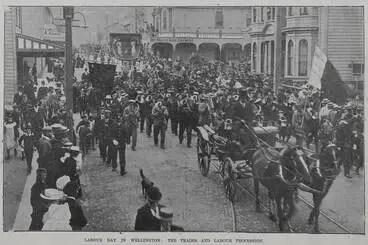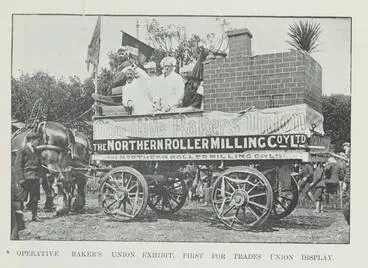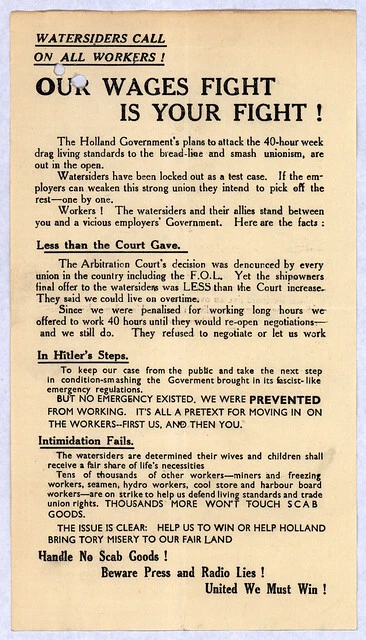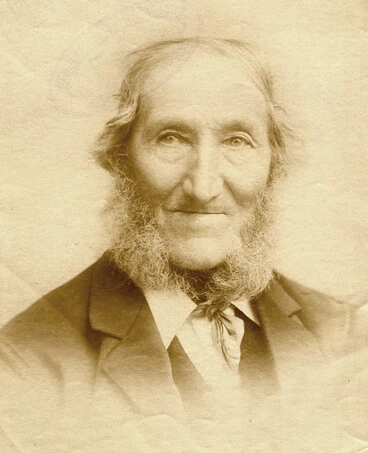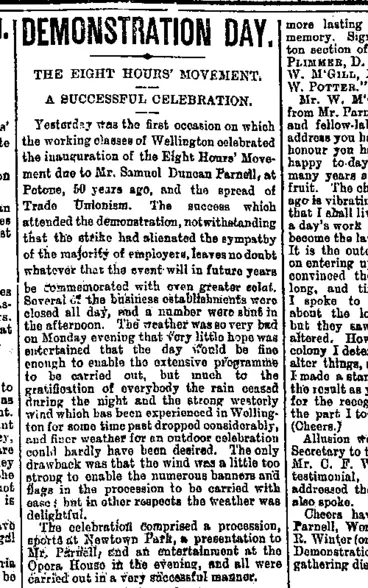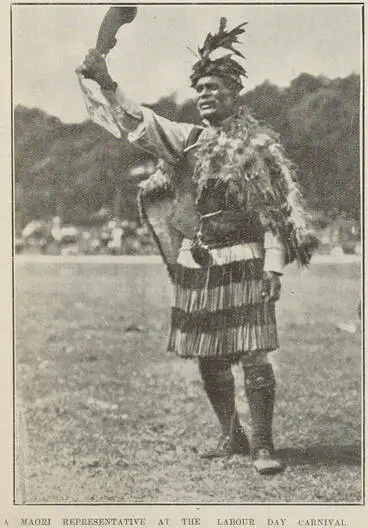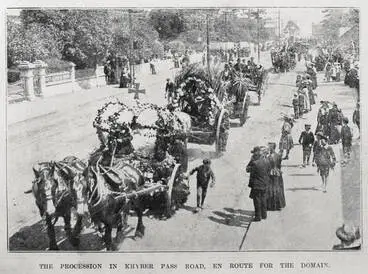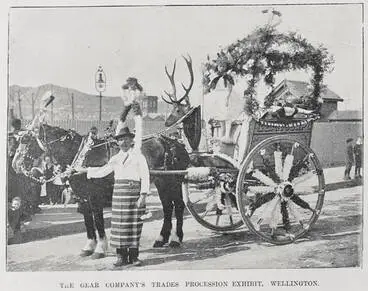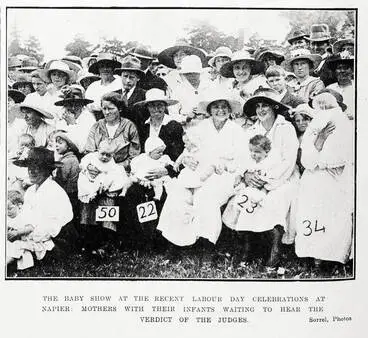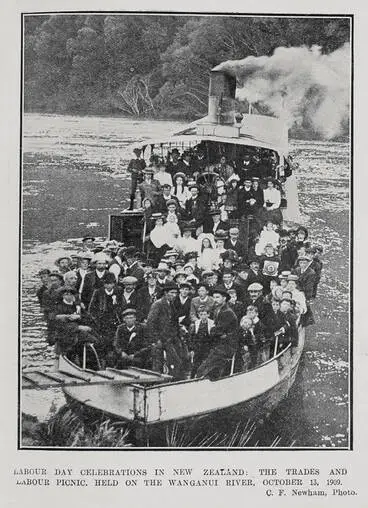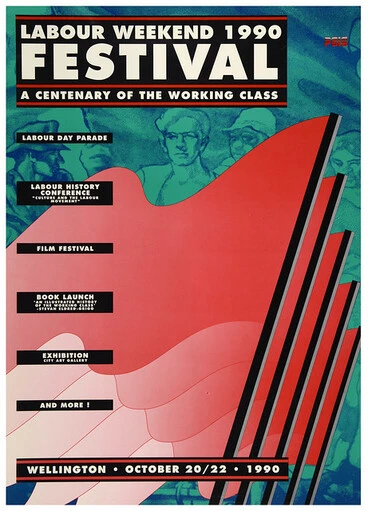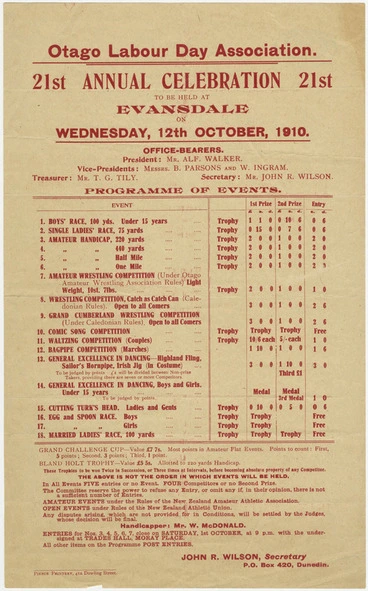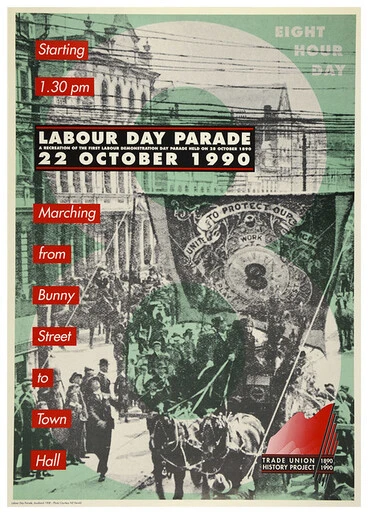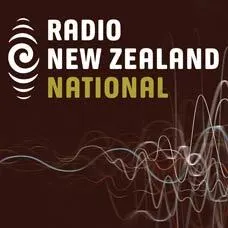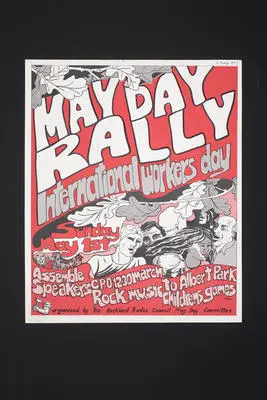Labour Day in New Zealand
A DigitalNZ Story by National Library Services to Schools
Parades, processions and floats filled the streets to celebrate Labour Day in New Zealand for the first time in 1890. This set has information and resources to help you understand more about the history and significance of this day in New Zealand.
LABOUR DAY IN NEW ZEALAND
Trades and labour procession on Labour Day in Wellington on 26 October 1900
Auckland Libraries
BACKGROUND
The origin of Labour Day lies in the fight for an eight-hour working day, improved working conditions and fair and just wages for work done.
Around the middle of the 19th-century, workers began to realise that long hours of work, poor working conditions and low wages were not only unjust but a form of exploitation. Labour disputes and protests were some of the ways that workers voiced their discontent. But individual protests were not powerful enough to impact changes for the working class. Labourers in all classes of work had to find a strong, unified voice to raise their issues with the government and with their employers. This led to the formation of trade unions.
Early unions in New Zealand
There were few employee organisations before the 1870s. Those that were set up usually fought a single battle, then disappeared. When workers disagreed with their employers, they used tactics devised in Britain.
The first organisations that represented the interests of employees in New Zealand were small, local trade unions, generally formed by settlers from England and Scotland. They had often belonged to a union in their own country, and were certainly familiar with the idea of organised labour.
Source: Early unions, 1840–1880 — Unions and employee organisations, Te Ara — The Encyclopedia of New Zealand.
In the 1880s unions won big victories, which encouraged many more workers to join. The Maritime Council – the first national labour organisation – was formed in 1889 by maritime workers and coal miners.
Labour government was elected in 1935, and worked closely with the union movement’s national body, the Federation of Labour (FoL). It became compulsory for workers to join the union that covered them. The government brought in a pension for all retired people, and two weeks’ paid holidays for workers.
From the 1970s, women and Māori worked for better representation from unions. Sonja Davies became the first woman on the FoL executive, in 1981. Unions began taking a stand on issues such as apartheid in South Africa and the Vietnam War.
Source: Unions and employee organisations, Te Ara — The Encyclopedia of New Zealand.
Shearers' demands
Manatū Taonga, the Ministry for Culture and Heritage
Miners’ union banner
Manatū Taonga, the Ministry for Culture and Heritage
Printing apprentices
Manatū Taonga, the Ministry for Culture and Heritage
New Zealand trade union leaders
Alexander Turnbull Library
Sonja Davies at an FoL meeting
Manatū Taonga, the Ministry for Culture and Heritage
Operative Baker's Union exhibit, first for trades union display
Auckland Libraries
Early labour disputes
The first recorded wage dispute in New Zealand was in the Bay of Islands in 1821. Māori timber-workers stopped work because they wanted to be paid ‘for their labour in Money, as was the case in England, or else in Gun Powder’. They were probably being paid with food and other goods, and felt this was unfair. The outcome of their strike is not known.
New Zealand’s most famous early labour dispute was in 1840 when a London-born carpenter named Samuel Parnell was asked to build a house in Petone, near Wellington.
Source: Early labour disputes — Strikes and labour disputes, Te Ara — The Encyclopedia of New Zealand.
Later labour disputes
In 1908 miners in Blackball, on the South Island’s West Coast, went on strike for a shorter work day and longer lunch break. After a three-month strike, the mining company agreed.
In 1912, 1,000 miners in Waihī went on strike. Police arrived, strikers were jailed and hundreds of strike-breakers did the jobs of the striking workers. Violence broke out and one striker was killed.
In 1951 the wharfies (waterside port workers) refused to work overtime, in protest over a low pay increase. Their employers locked them out of the workplace, and the government banned union meetings and publications. It was illegal even to give food to strikers’ children. Other unions supported the wharfies, and 22,000 people were out of work for five months.
Source: Strikes and labour disputes, Te Ara — The Encyclopedia of New Zealand.
Blackball miners' strike cartoon
Manatū Taonga, the Ministry for Culture and Heritage
Strike supporters at 1912 Waihi strike
Manatū Taonga, the Ministry for Culture and Heritage
1951 Waterside Dispute
Archives New Zealand Te Rua Mahara o te Kāwanatanga
Union march during 1951 waterfront dispute
Manatū Taonga, the Ministry for Culture and Heritage
Blackball mine
Manatū Taonga, the Ministry for Culture and Heritage
Strikebreakers, including Hubert Percy Barry, during the 1912 Waihi miners' strike
Alexander Turnbull Library
SAMUEL PARNELL — FOUNDER OF THE EIGHT-HOUR WORKING DAY IN NEW ZEALAND
Fought for an 8 hour day as a carpenter at Petone in early 1840
Manatū Taonga, the Ministry for Culture and Heritage
Parnell was born in London, where as a young man he worked at a large joinery. Shortly after his marriage in September 1839, he left for New Zealand on the Duke of Roxburgh, arriving at Britannia (Petone) beach on 8 February 1840. Among Parnell's fellow passengers was a shipping agent, George Hunter, who asked the carpenter to build him a store. Parnell's response has entered New Zealand folklore:
I will do my best, but I must make this condition, Mr. Hunter, that on the job the hours shall only be eight for the day ... There are twenty-four hours per day given us; eight of these should be for work, eight for sleep, and the remaining eight for recreation and in which for men to do what little things they want for themselves. I am ready to start to-morrow morning at eight o'clock, but it must be on these terms or none at all.
'You know Mr. Parnell,' Hunter replied, 'that in London the bell rang at six o'clock, and if a man was not there ready to turn to he lost a quarter of a day'.
'We're not in London', said Parnell. With few tradesmen in the young settlement, Hunter had little choice but to accept the carpenter's terms. As Parnell later wrote, 'the first strike for eight hours a-day the world has ever seen, was settled on the spot.'
Other employers tried to impose longer hours, but Parnell enlisted the support of other workmen and informed those arriving on incoming ships of the local custom. In October 1840 a meeting of Wellington workmen apparently resolved to work eight hours a day, from 8 a.m. to 5 p.m. – anyone offending would be ducked into the harbour.
Source: Samuel Parnell — Biographies, NZHistory
First Labour Day procession, Dunedin
Manatū Taonga, the Ministry for Culture and Heritage
THE FIRST LABOUR DAY CELEBRATED
Labour Day was first celebrated in New Zealand on 28 October 1890, when several thousand trade union members and supporters attended parades in the main centres. Government employees were given the day off to attend the parades and many businesses closed for at least part of the day.
Source: Labour Day — Protest and Reform, NZHistory.
Eight Hour Day Committee, 1890
Manatū Taonga, the Ministry for Culture and Heritage
Report of first Labour Day, 1890
Manatū Taonga, the Ministry for Culture and Heritage
The Eight Hour Day Demonstration. (Nelson Evening Mail, 29 October 1890)
National Library of New Zealand
Page 1 Advertisements Column 8 (Auckland Star, 17 April 1882)
National Library of New Zealand
Labour Day parade
Manatū Taonga, the Ministry for Culture and Heritage
17 Labour Day Act 1899
The University of Auckland Library
Labour Day becomes a statutory holiday
Early Labour Day parades drew huge crowds in places such as Palmerston North and Napier as well as in Auckland, Wellington, Christchurch and Dunedin. Unionists and supporters marched behind colourful banners and ornate floats, and the parades were followed by popular picnics and sports events.
These parades also had a political purpose. Although workers in some industries had long enjoyed an eight-hour day, it was not a legal entitlement.
Unionists wanted the Liberals to pass legislation enforcing an eight-hour day for all workers, but the government was reluctant to antagonise the business community.
What the Liberals did do was make Labour Day a holiday. The Labour Day Act of 1899 created a statutory public holiday on the second Wednesday in October, first celebrated in 1900. The holiday was 'Mondayised' in 1910, and since then it has been held on the fourth Monday in October.
Source: Labour Day — Protests and reform, NZHistory.
A Māori representative at the Labour Day carnival
Auckland Libraries
Labour Day Celebrations In New Zealand
Auckland Libraries
Labour Weekend Festival, 1990
Archives New Zealand Te Rua Mahara o te Kāwanatanga
Going to the Labour Day picnic, Evansdale, 1905
Manatū Taonga, the Ministry for Culture and Heritage
Otago Labour Day Association. 21st Annual Celebration poster
University of Otago
Poster celebrating 100 years of Labour Day Parades, 1990
Manatū Taonga, the Ministry for Culture and Heritage
International Workers Day around the world
Also called May Day or International Day of Labour, this day celebrates the eight-hour workday and better working conditions for labourers and the working class. It falls on 1 May or 1 September and in some countries is a public holiday.
May Day Panel
Radio New Zealand
China Series: May Day Parade 1957
Museum of New Zealand Te Papa Tongarewa
May Day Rally
Auckland War Memorial Museum Tāmaki Paenga Hira
QUICK FACTS
- 'Arbitration' is when a mediator assists to resolve a dispute between workers and employers who cannot agree on wages and working conditions.
- In the 1800s schoolboys went on strike against receiving too much homework.
- ‘Sweating’ was a term used to describe the exploitation of labour through long working days and low wages.
- The Maritime Strike of 1890 broke out in New Zealand when the Union Shipping Company refused to pass on a wage increase to ship officers.
- The Waihi Miners Strike of 1912 was a strike of 1,000 members of the Waihi Miners Union against the formation of a breakaway union by a group of gold-mine engine drivers.
- In February 1951 New Zealand wharfies (wharf labourers) began an industrial strike because ship owners refused to pay a 15% increase in salaries that was decided by the Arbitration Court.
Definitions below have been taken from the Oxford Learner's Dictionary.
antagonise — to do something to make somebody angry with you.
ducked — to push somebody underwater and hold them there for a short time.
entitlement — the official right to have or do something.
exploited — to treat a person or situation as an opportunity to gain an advantage for yourself.
folklore — the traditions and stories of a country or community.
joinery — the work of a joiner or things made by a joiner ( joiner — a person whose job is to make the wooden parts of a building, especially window frames, doors, etc.)
legislation — a law or a set of laws passed by a parliament.
statutory — fixed by law; that must be done by law.
tradesmen — a person whose job involves going to houses to sell or deliver goods.
trade-union — an organization of workers, usually in a particular industry, that exists to protect their interests, improve conditions of work, etc.
unionists — a member of a trade union.
Garden centre shopping, Labour Day 2005
Manatū Taonga, the Ministry for Culture and Heritage
OTHER RESOURCES
Celebrate May Day! — originating in America, workers in many countries take to the street to proclaim international solidarity for the rights of workers against exploitation.
Haymarket Martyrs: Origin of International Workers— public Broadcasting Service (PBS) looks at one of the incidents that gave rise to International Workers Day--May 1 or Mayday.
The Haymarket Square Riot— historian Yohuru Williams gives a crash course on a riot in Chicago's Haymarket Square that changed the labor movement in the United States.
International Worker's Day— besides covering the history of this day, the British Council has tasks, exercises, and discussion questions to raise inquiry about this topic.
International Worker's Day facts— and images from countries around the world celebrating this day over the years.
Labor Day's violent beginnings — the bloody Pullman strike in 1894 spurred the national holiday that recognizes American workers.
Labour Day Collection — A collection of 20 videos from NZ On Screen on New Zealand working life covering economic revolutions, industrial disputes, public service and the role of unions.
May Day— also called Worker's Day amongst other names, came about after historic struggles all over the world.
May Day is not about maypoles — the history of the international worker's day from The Guardian.
Samuel Duncan Parnell — the founder of the 'Eight Hour System'.
Labour Day Humour
"What do you like most about Labour Day - the long weekend or the short working week?" 25 October 2010
Alexander Turnbull Library
Evans, Malcolm Paul, 1945- :Labour Day Specials. 22 October 2012
Alexander Turnbull Library
Evans, Malcolm Paul, 1945- :Labour Day. 26 October 2014
Alexander Turnbull Library
Evans, Malcolm Paul, 1945- :Labour Weekend Holiday. 27 October 2013
Alexander Turnbull Library
Bromhead, Peter, 1933-:Labour Day today... 28 October 2013
Alexander Turnbull Library
The Eight hour day. 24 October 2010
Alexander Turnbull Library
This story was curated and compiled by Te Puna Mātauranga o Aotearoa | National Library of New Zealand, Services to Schools staff, October 2020.
